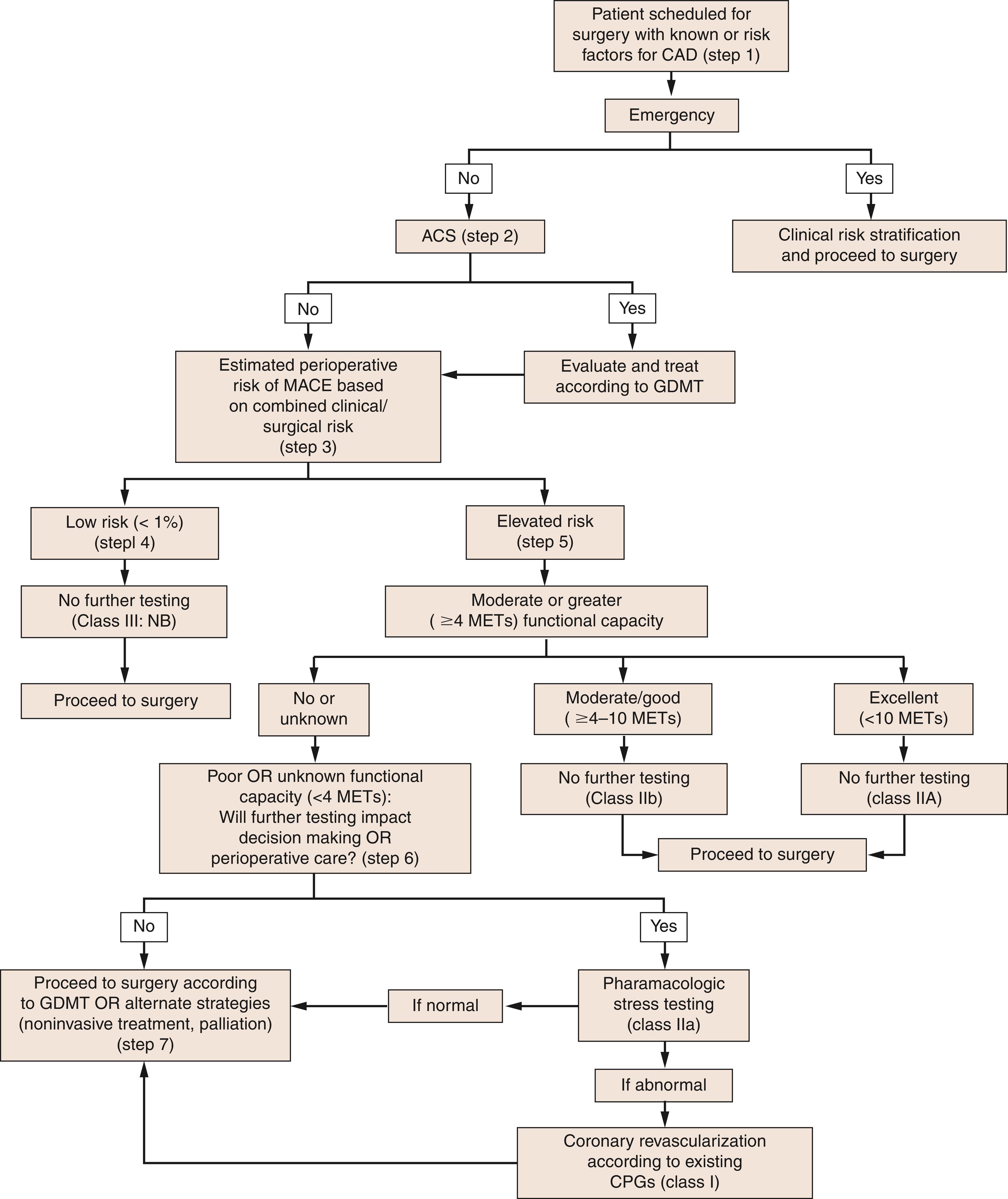Physical Address
304 North Cardinal St.
Dorchester Center, MA 02124
Anesthesia has become increasingly safer. According to the Anesthesia Quality Institute’s National Anesthesia Clinical Outcomes Registry, comprising over 30 million cases, perioperative mortality has significantly decreased in high-income countries despite a population increasingly burdened by severe comorbidities. Nevertheless, cardiac complications are still common after noncardiac surgery, with myocardial infarction (MI) being the single most common cause of death. Annually, 4% of the world’s population will undergo a surgical procedure, and 30% of those patients have at least one cardiovascular risk factor. The 30-day mortality of patients with at least one cardiovascular risk factor is 0.5%–2%. Many efforts have been made to quantify risk through indices and algorithms in multivariate analyses. However, although cardiac risk can be measured, interventions are often not performed in a timely manner. This chapter’s focus is to assist the physician responsible for the well-being of the patient scheduled for surgery to do the following: (1) clinically assess the patient’s current medical status and provide a clinical risk profile, (2) decide whether further cardiac testing is indicated prior to surgery, and (3) make recommendations concerning the risk of perioperative cardiac complications and alter management with the purpose of lowering that risk.
Once a patient decides to undergo a surgical procedure, an entire care team is dedicated to ensuring that there are minimal complications during the perioperative process. The perioperative evaluation is a multidisciplinary effort with good communication between the patient, primary care physician, anesthesiologist, cardiologist, and surgeon. For elective procedures, patients should schedule an appointment with their primary care physician in order to undergo initial presurgical screening. The primary care evaluation will consist of a detailed history, physical examination, and review of pertinent laboratory data. A thorough review of the medical record is done to identify any previous cardiac examination or workup: electrocardiogram (ECG), echocardiography, stress testing, or cardiac catheterization. As part of the physical examination, physicians should assess for signs or symptoms of cardiopulmonary dysfunction and any associated comorbidities. The overall goal is to identify active cardiac conditions that may have developed in the months preceding noncardiac surgery. The aim of appropriate preoperative evaluation and therapy in individuals with established coronary artery disease (CAD) is not only to improve immediate perioperative outcome but also to improve the long-term clinical outcome.
The severity, frequency, and duration of symptoms, as well as treatments initiated, should be recorded. A detailed physical examination of the cardiovascular system is performed, looking for evidence of heart disease ( Table 5.1 ). In addition to the physical examination findings, a detailed review of the history can identify clinical predictors of cardiovascular risk. Table 5.2 lists the clinical predictors of perioperative cardiovascular risk. Major risk factors require immediate attention, whether through testing or cardiology consultation, in order to lower the long-term risk, regardless of the need for surgery. In emergent nonelective cases, the benefits of proceeding with surgery frequently outweigh the risk of waiting for additional testing. In such situations, physicians must be ready to manage cardiovascular complications intraoperatively as well as postoperatively in at-risk patients. It is worth mentioning that abnormal findings of a physical examination as well as extracted from the patient’s history may justifiably warrant postponing the scheduled surgical procedure.
| Location | Signs | Symptoms | Complaints |
|---|---|---|---|
| Hands | Clubbing Splinter hemorrhages |
Heart failure | Dyspnea Orthopnea Tachypnea Asthma unresponsive to bronchodilator |
| Radial pulse | Rate/rhythm/volume Character/contour Bruits Symmetry |
Arrhythmia | Palpitations Dizziness Syncope Orthostatic |
| Blood pressure |
Systolic + diastolic Hypertension Hypotension |
Coronary artery disease |
Angina Dyspnea |
| Carotid pulse |
Volume Character Bruit |
Auscultation: cardiac | New systolic + diastolic murmurs S3 heart sounds |
| Jugular venous pressure |
Height Waveform |
Auscultation: lungs | Rales/rhonchi crackles/wheeze |
| Face Mouth Eyes |
Pallor Central cyanosis Malar flush Dental caries Fundi |
Abdomen | Hepatomegaly Ascites Aortic aneurysm bruit |
| Precordium | Apical impulse Thrills/heaves Scar |
Legs | Peripheral pulses Edema Calf pain |
| Skin | Skin temperature Sweating Urine output |

| Major | Intermediate | Minor |
|---|---|---|
| Unstable ACS | Mild angina b | Advanced age |
| MI within 60 days | Prior MI: pathologic Q waves | Abnormal ECG (LVH, LBBB, ST-T abnormality) |
| Unstable angina b | Compensated/prior heart failure | Rhythm other than sinus |
| Decompensated heart failure | Diabetes mellitus | Low functional capacity |
| High-grade arrhythmia | History CVA | |
| Severe valvular disease | Uncontrolled systemic HTN | |
| SVT with uncontrolled ventricular response | Obesity |
a Risk includes myocardial infarction, congestive heart failure, and death.
b May include stable angina in unusually sedentary patients.
Unless the patient is undergoing a low-risk surgery, an ECG is obtained in patients with cardiovascular disease, arrhythmias, or structural heart disease, as recommended by 2014 guidelines of the American College of Cardiology/American Heart Association (ACC/AHA) and the European Society of Cardiology/European Society of Anaesthesiology (ESC/ESA). Although ECG abnormalities have an inconsistent prognostic factor, they serve as a baseline in the event that perioperative complications arise. The ECG should be evaluated for the presence of Q waves, significant ST-segment elevations and depressions, ischemia, infarction, left ventricular (LV) hypertrophy, QTc prolongation, bundle branch block, or arrhythmia.
Become a Clinical Tree membership for Full access and enjoy Unlimited articles
If you are a member. Log in here